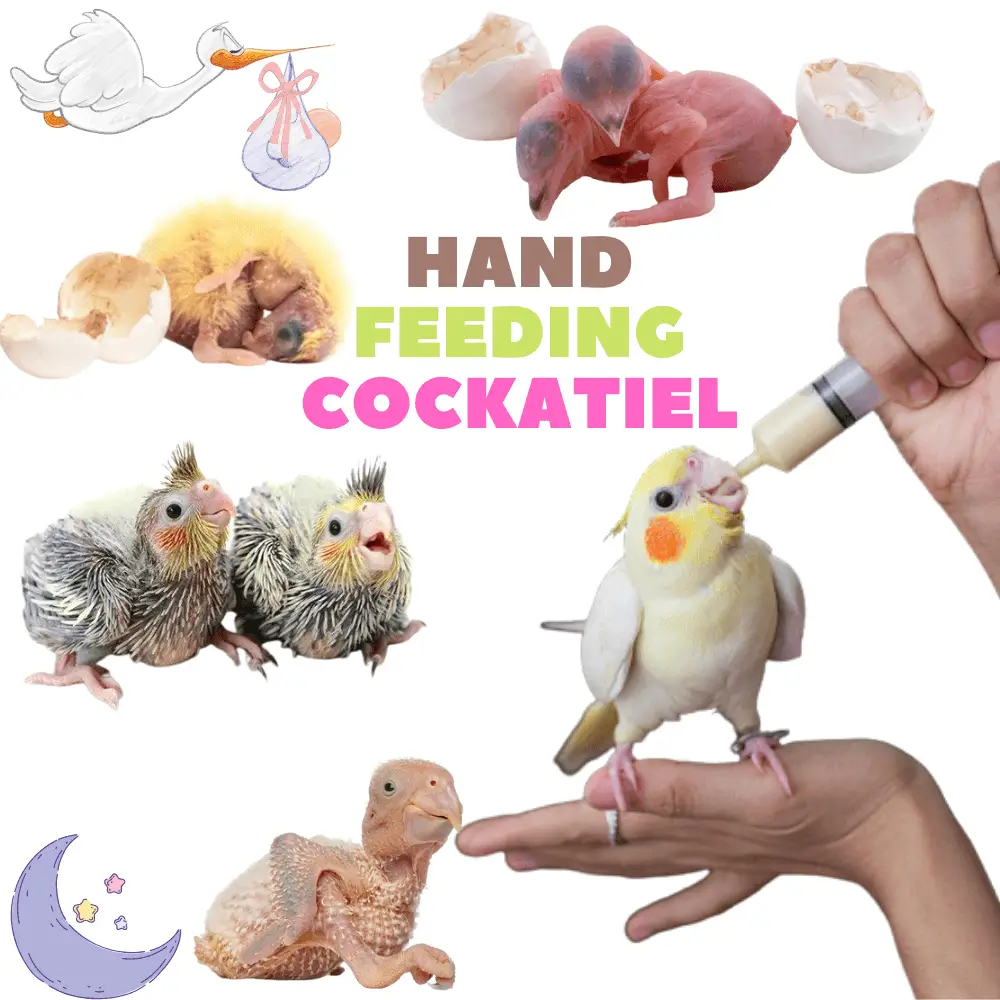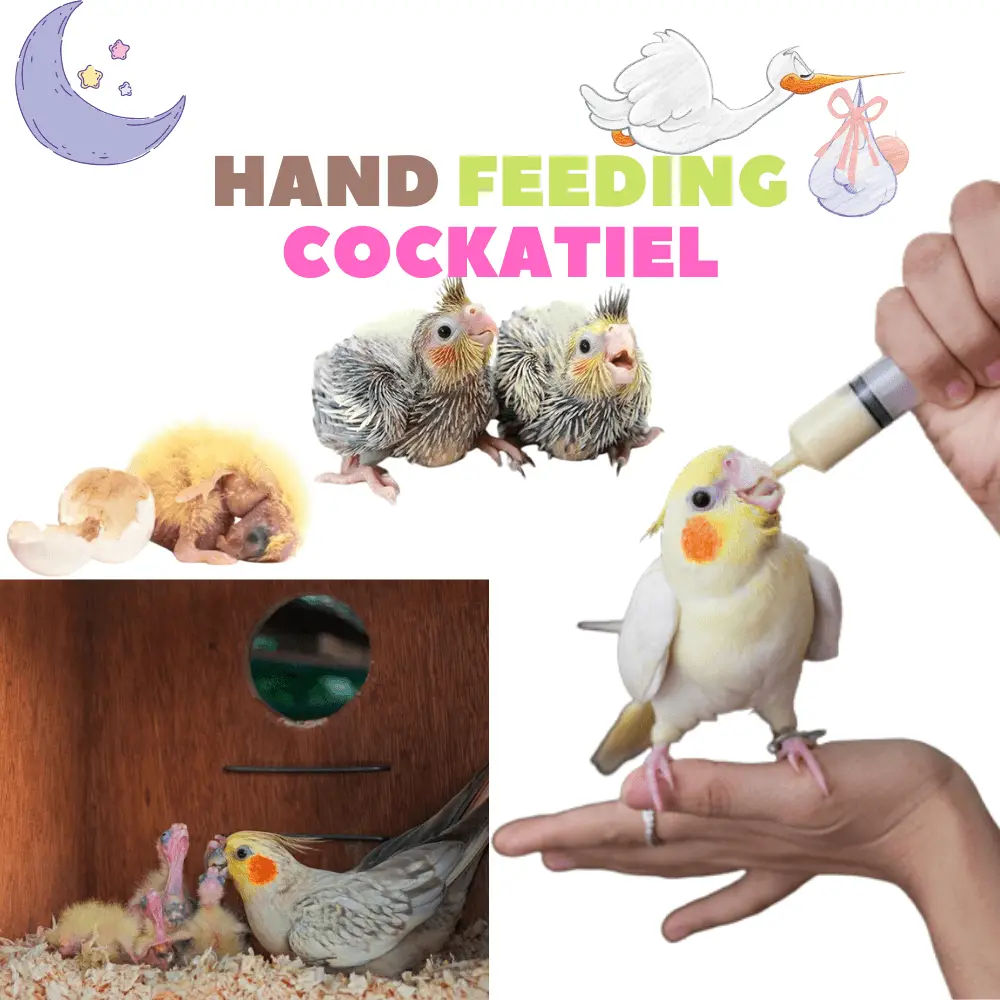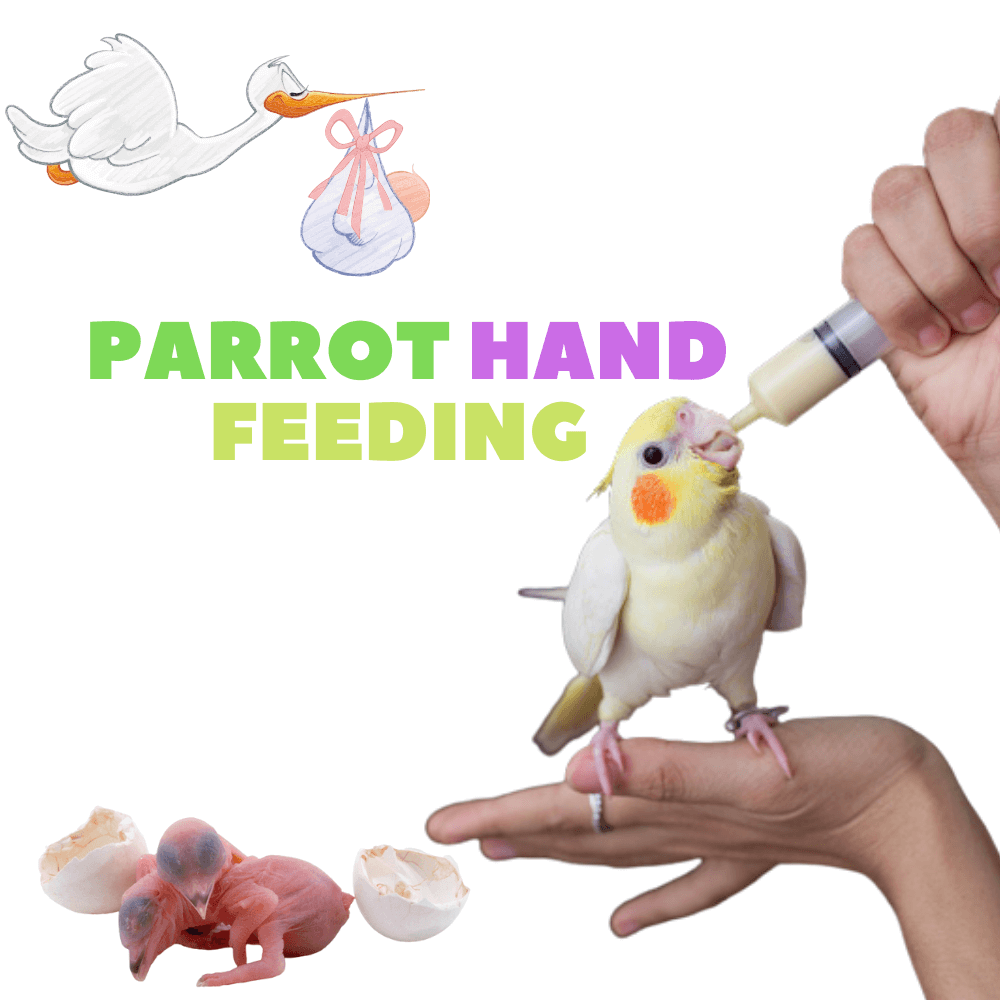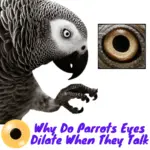
What is parrot Hand-Feeding? Hand-feeding cockatiel: how to hand feed an unweaned parrot? This topic is mainly aimed at people who have in their possession a bird weaned before term and who are obliged to complete this work.
It is in no way intended to encourage the delicate practice of hand-feeding, which is too risky for the uninitiated. It is a question here of providing advice aimed at optimizing the chances of survival of birds weaned too brutally by the force of nature (death of parents or malnutrition for example) or their breeder, not to arouse a craze for this practice.
Hand feeding baby cockatiels from 2 hours old to 2 weeks old
SOURCE:Bird Squawk
When mixing the paste with water to prepare the porridge, conscientiously follow the manufacturer’s instructions, taking care to use bottled spring water or cooled boiled water, in order to eliminate the bacteria present. There is nothing to cook, regardless of the brand used, in general. The temperature must remain constant, between 35 and 37 °C. This is why the use of a water bath where to place the preparation is essential. Despite the apparent practicality of a microwave oven, do not use this method to heat the porridge, as it presents a major danger. Indeed, the waves do not evenly heat the substances, which generates cold and other boiling areas and would have the unfortunate consequence of seriously burning the chick’s crop.
Hand feeding cockatiel

Cockatiel Mutations:
As for the choice of accessories, whether you opt for the spoon or syringe, the cooling of the contents is quite fast. With a syringe, it is the portion contained in the tip that stays warm for the shortest time. Between two spouts, it must therefore be immersed in hot water.
With experience, a breeder takes about twenty to thirty seconds only to feed a cub. But for the uninitiated, it takes more time. What matters is not to force your parrot to eat too fast, so that it does not choke or make a false swallow. Between each spout, wipe spout with a clean paper towel or cloth. Overall, the administration time of each spout should not last more than a few seconds, regardless of the method chosen. This allows him to breathe and take the time to swallow what is already in his beak.
In order for the consistency to be good, it is necessary to be able to suck the porridge into a straw. If this is not possible, it is because it is too thick. In this case, the juvenile may not be able to empty its crop properly during digestion. In addition, the paste can suck up the fluids present in the body and dehydrate the animal. But from one brand to another, the right consistency changes significantly.
Once ready to use, some are therefore more liquid than others. The paste marketed by Versele Laga for example, whether it is the Nutribird A19 or Nutribird A21 formula, requires a dose of powder for 2 to 2.5 doses of water. The creaminess usually corresponds to that of a yogurt. What matters, once again, is to comply with the manufacturer’s recommendations. To make sure that the resulting consistency is final, you can also cover it and leave it warm for ten minutes, before checking it again.
It is always better to continue feeding with the same paste, so as not to disturb the little one. The difference in taste can indeed displease him. As such, your breeder can generally tell you, or sell you, which one he uses. However, if you need to change them, try to make a smooth transition, mixing the two for a day or two, taking care to carefully read the instructions on the new package, so as not to make a dosage error. Always remember to leave available, at the same time, a mixture of seeds as well as fresh fruits and vegetables, to facilitate the transition to solid food.
Most of the parrots available on the market come from farms
Hand feeding cockatiel

The expression “hand-fed” means:
- That the chicks are removed very early from the nest or, sometimes even, born in an incubator;
- Whether they have no or few filial contacts;
- Consequently, they undergo in a systematized way, a human impregnation.
The parrot is the only “domestic” animal that is doctrinally subjected to this kind of trauma. This breeding method will have repercussions on all the behaviors of the bird.
Thus, the young parrot will develop …
- Without being too conscious of his identity;
- He will create fictitious attachments with the human;
- Sometimes even going so far as to reject interactions with individuals of its own species.
Since the bird’s filial imprint will be human …
- He will develop attitudes that will be programmed by humans;
- These attitudes risk conflicting with the prescriptions of his instincts.
Yes, but what is the imprint?
Basically, imprinting is an aspect of learning that occurs at a very early age ( before food weaning ), at a time when the young parrot is very sensitive and where it is exposed to a very significant stimulus … imprint creates an exclusive relationship between the chicks and his or her parents ( depending on the species ) around food intake, the beak and around the security of the place.
Hand feeding cockatiel

The bird attaches itself to a model that is present …
- As soon as he begins to become aware of the environment around him ( opening of the eyes and ears ).
Although this model is usually the mother …
- It could just as well be another animal species ( in our case: humans ).
We are therefore talking about the definitive establishment of a link between an external trigger and instinctive behavior.
- This establishment is not controlled by a specific biological determinism ( such as a family link, and odor ) but would be circumstantial.
- The impregnation will be done with the being who will be there when it happens. That’s all.
The imprint has very long-term repercussions:
- Recognition of parents;
- Identity ( learns the characteristics of its parent );
- Attachment;
- Relationships and social adaptation; – The types of individuals with whom he will have privileged relations.
- The filial impression induces the sexual imprint of the bird ( characteristic of the parent, of the species ).
The imprint is a fast, specific, and irreversible form of learning:
- This form of learning is most effective since it does not require any form of reinforcement;
- It is a phenomenon that is part of the survival instinct of animals.
The behaviors that will be acquired by impregnation …
- May remain permanent and will be decisive in other subsequent behaviors of the bird.
Failed impregnation will produce a bird with an active defense system:
- A bird that has experienced loopholes in attachment and detachment will experience anxiety whenever faced with a situation of detachment.
- By becoming anxious, the bird will not be able to learn with confidence.
- Impregnation is a major step in the animal’s learning process.
Hand Feeding Baby Cockatiels
SOURCE:VT Vlogs
Heterospecific and systematic impregnation of humans
It is the very source of most of the dysfunctions or behavioral problems of Hand Feeding parrots.
- The pathogenic impregnation leads to disabling relational orientations for the bird.
- Among others, extra specific sexual impregnation and/or double intra and extra specific impregnation.
- It will cause dysfunctions in sexual behavior, parents, and disorders in the social system.
Thus, the first learning of the young bird will be the filial impregnation:
- Recognition of the characteristics of its parent.
- And at Hand Feeding, this impregnation will be human.
The bird will consider being the only species the human.
- He will take the human as a model in his social learning and for his survival – ( and what he will learn from it will certainly not always be to please you ).
- He will expect the social pressure of his group to be consistent with his parrot status (which he identifies with humans of course ) – which he can understand or accomplish.
- He will expect to be able to communicate with his species: = as naturally as possible,
– in both directions = to be understood and to understand. - He will expect your mutual needs to be similar, if not the same.
- They will expect to be accepted and to be a (full) part of their social group ( your family ).
- And later, he might expect to choose and take as his husband or wife one of the members of this social group.
Did you expect this?
Far from me the idea of blaming the breeder or the buyer ( or both ) …
- But I have to admit that the situation does exist and that it might be time to remedy it ( since the information is available ).
The breeder’s responsibility

Hand feeding cockatiel
Would be to see that the chick can benefit from a period of “normal” impregnation with its parents ( its species ):
- Most species take care of their offspring as a couple.
- Understand that parrots are one of those species that have a long period of juvenile dependence since they also have a long life expectancy.
Thus, a long period of dependence … means … a long period of impregnation, particularly in certain species with a longer period of dependence, such as large parrots or monospecific species. This impregnation largely exceeds the framework of 12 weeks ( 3 months ) and, therefore, it is possible that the period of “natural” socialization of certain species can extend beyond the age of 16 months to 24 months.
If we compare with current breeding methods… we are far from the mark.
Now, since the parrot has a very low reproduction rate, if not for commercial reasons …
- Breeders will, I hope, in the near future have to justify their motivations for continuing to practice this form of breeding which would be considered barbaric if a dog breeder decides to act in this way.
- Cui bono? ( Cicero ) – Who benefits?
The task of raising parrots should not be improvised. A ( minimal ) knowledge of what happens in the first weeks or months of life of different species of parrots should be able to avoid abuse, through ignorance or neglect, avoid producing young birds with a pathogenic impregnation, poorly socialized, and consequently, ill-prepared to live in an environment which is not at all adapted ( nor prepared ) to meet their needs… their future human family.
Parrot breeder responsibility
- Stop ( grace ) thinking in terms of “puppy or kitten” in wishing to obtain the chick as young as possible.
- Stop believing that the bird will create attachment + if you feed it yourself.
Keep in mind that:
- The breeder has a product to sell, and he will produce what you ask him to do!
- You only take care of half of the work that should fall to the breeder.
- Would you be willing to get a high price for an “unfinished” puppy?
Dangers and Risks of Hand-feeding Baby Birds
- Would be not to agree to adopt an animal with such a badly conducted impregnation;
- To understand that he does not have at all the qualifications required to undertake the heavy task of weaning the chick himself.
The risks to physical and psychological development are too numerous to be left in the hands of novices:
- Aspiration pneumonia;
- Severe burns of the crop;
- Anorexia ( food that is too cold or too hot );
- Starvation;
- Risk of disease ( the baby’s immune system is not fully developed );
- ( High ) risk of not recognizing a symptom that indicates the bird is not doing well.
… And to understand that the period of socialization of the young bird is too important for one to be able to decide to lead it oneself. Without at least having a good basis of the needs and the ethogram ( natural and normal behaviors ) of the species that one decides to adopt.
For those who intend to get a young parrot, remember that you have nothing to gain by getting a young animal …
- At morbid impregnation;
- Deficient in his emotional, emotional, and often nutritional needs …
- … And whose socialization will be deficient for all these reasons.
Because, whatever may be said, even the most concerned of breeders will never replace the reassuring and structuring presence of the parents themselves.
Before acquiring a baby parrot from the breeder, get informed, and ask for a young whose feeding, weaning, and first socialization were conducted by the natural parents ( EPP- raised by the parents ). A conscientious breeder concerned with the well-being of his young will have no reason to refuse you such a request.
For others (those who have already acquired a Hand Feeding – hand raised), I can only invite you to continue to visit the pages of this site to try to improve the living environment of your bird. to pathological impregnation. Understand that this is not a given!
Related Articles:




















